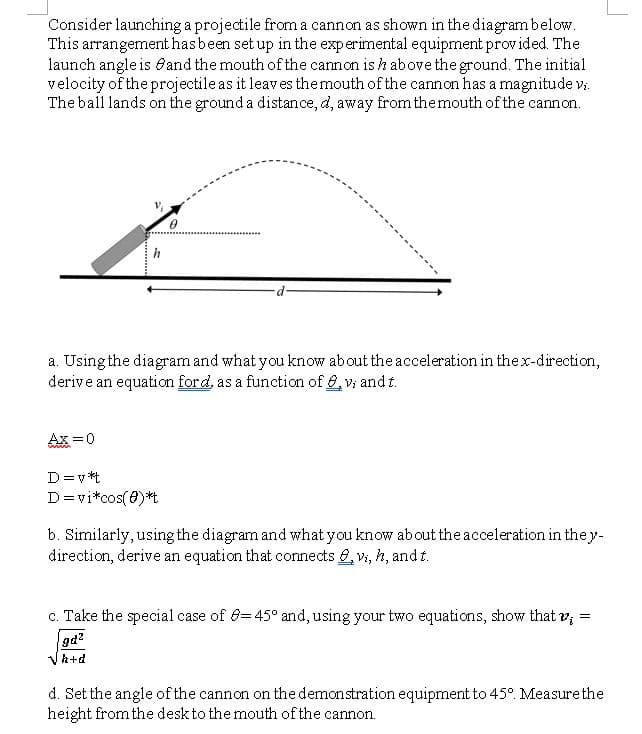Consider launching a projectile from a cannon as shown in the diagram below. This arrangement has been set up in the experimental equipment prov ided. The launch angle is 6and the mouth of the cannon is h above the ground. The initial velocity of the projectile as it leaves the mouth of the cannon has a magnitude v. The ball lands on the ground a distance, d, away from the mouth of the cannon.
Consider launching a projectile from a cannon as shown in the diagram below. This arrangement has been set up in the experimental equipment prov ided. The launch angle is 6and the mouth of the cannon is h above the ground. The initial velocity of the projectile as it leaves the mouth of the cannon has a magnitude v. The ball lands on the ground a distance, d, away from the mouth of the cannon.
Elements Of Electromagnetics
7th Edition
ISBN:9780190698614
Author:Sadiku, Matthew N. O.
Publisher:Sadiku, Matthew N. O.
ChapterMA: Math Assessment
Section: Chapter Questions
Problem 1.1MA
Related questions
Question
part b,c and d

Transcribed Image Text:Consider launching a projectile from a cannon as shown in the diagrambelow.
This arrangement has been set up in the experimental equipment provided. The
launch angle is 6and the mouth of the cannon is h above the ground. The initial
velocity of the projectile as it leaves themouth of the cannon has a magnitude v:
The ball lands on the ground a distance, d, away from themouth of the cannon.
............
a. Using the diagram and what you know about the acceleration in the x-direction,
derive an equation ford, as a function of 6, vi and t.
Ax =0
D=v *t
D=vi*cos(0)*t
b. Similarly, using the diagram and what you know ab out the acceleration in they-
direction, derive an equation that connects , v, h, and t.
c. Take the special case of 8=45° and, using your two equations, show that v,
=
gd?
Vh+d
d. Set the angle of the cannon on the demonstration equipment to 45°. Measurethe
height from the desk to the mouth of the cannon.
Expert Solution
This question has been solved!
Explore an expertly crafted, step-by-step solution for a thorough understanding of key concepts.
Step by step
Solved in 3 steps

Knowledge Booster
Learn more about
Need a deep-dive on the concept behind this application? Look no further. Learn more about this topic, mechanical-engineering and related others by exploring similar questions and additional content below.Recommended textbooks for you

Elements Of Electromagnetics
Mechanical Engineering
ISBN:
9780190698614
Author:
Sadiku, Matthew N. O.
Publisher:
Oxford University Press

Mechanics of Materials (10th Edition)
Mechanical Engineering
ISBN:
9780134319650
Author:
Russell C. Hibbeler
Publisher:
PEARSON

Thermodynamics: An Engineering Approach
Mechanical Engineering
ISBN:
9781259822674
Author:
Yunus A. Cengel Dr., Michael A. Boles
Publisher:
McGraw-Hill Education

Elements Of Electromagnetics
Mechanical Engineering
ISBN:
9780190698614
Author:
Sadiku, Matthew N. O.
Publisher:
Oxford University Press

Mechanics of Materials (10th Edition)
Mechanical Engineering
ISBN:
9780134319650
Author:
Russell C. Hibbeler
Publisher:
PEARSON

Thermodynamics: An Engineering Approach
Mechanical Engineering
ISBN:
9781259822674
Author:
Yunus A. Cengel Dr., Michael A. Boles
Publisher:
McGraw-Hill Education

Control Systems Engineering
Mechanical Engineering
ISBN:
9781118170519
Author:
Norman S. Nise
Publisher:
WILEY

Mechanics of Materials (MindTap Course List)
Mechanical Engineering
ISBN:
9781337093347
Author:
Barry J. Goodno, James M. Gere
Publisher:
Cengage Learning

Engineering Mechanics: Statics
Mechanical Engineering
ISBN:
9781118807330
Author:
James L. Meriam, L. G. Kraige, J. N. Bolton
Publisher:
WILEY